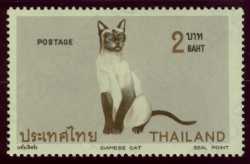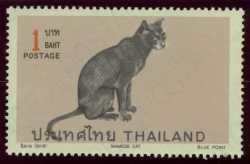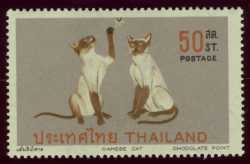Tanzania
1996


Because of its association with Siamese royalty, the Siamese Cat has also been called "The Palace Cat," "The Royal Siamese," or "The Royal Cat of Siam." Terms used to describe the Siamese include unpredictable, demanding, noisy, thieving, mischievous, determined, lively, active, agile, demonstrative, domineering, graceful, loyal, affectionate, devoted, intelligent and resourceful. Perhaps the most unusual feature of the Siamese, which sets it apart from other breeds, is its voice. No other cat is quite so noisy!
The body of the cat is light in color, but its extremities are dark. The cat is actually a dark-coated animal carrying a gene which inhibits the pigmentation of its fur if its body temperature rises above a certain level, so, where the cat's surface is coolest -- on its extremities -- the pigment is able to develop normally, but where its surface is hottest -- around the main trunk of its body -- the pigment is unable to develop and the coat remains pale. When Siamese kittens are born, emerging from the heat of the womb, they are hot all over and therefore pale all over, but as they grow older, their extremities gradually become cooler and darken. In elderly Siamese, the whole body becomes slightly cooler and all the fur darkens a little.
The blue-eyed Siamese has a highly characteristic shape, being slim, elongated and angular. The earliest examples of this breed had two additional features: a crooked, kinked tail and inward-squinting eyes. Legend has it that the blue eyes were gained as a result of the devoted courage of these cats when defending a sacred altar. Raiders of the temple were confronted by the menacing cats sitting on the altar steps, and, frightened, they left the altar untouched. The fiery red of the animals' eyes was then turned to a heavenly blue, reflecting the way in which they had served heaven in their stand against the barbarians. The kinked tail and squinting eyes of the breed are said to be the result of the escapades of an intoxicated monk. This particular monk, who served in a temple that housed a golden goblet once used by the Great Buddha, was in the habit of disappearing for days on end, leaving his pair of Siamese Cats to guard the sacred goblet. Eventually the male Siamese decided to seek a replacement for the monk and set out in search of another holy man. The female Siamese stayed behind to guard the precious goblet on her own, and she stared at it so hard and so long that she developed a permanent squint. As the days passed she became so exhausted that she wrapped her tail around the goblet and sank into a deep sleep. When the male cat finally returned with a new monk, they found the female, still protecting the goblet, but now surrounded by a litter of five kittens, all with crossed eyes and kinked tails.
It is often stated that the Siamese Cat was of such elevated status that it was confined solely to the Royal Palace of the King of Siam and that the theft of one was punishable by death. A modified view suggests that this type of cat was also present in many princely homes, in the mansions of Siamese aristocracy, and in the precincts of the sacred temples. According to one frequently repeated tale, the role of this breed was not merely to rid the palaces and mansions of rodents, but to provide a repository for the souls of the human occupants when their earthly lives ended. When a member of the royal family died, one of their favorite cats would be entombed with them. This was not as cruel as it may sound because there were a number of holes in the roof of each tomb, through which an athletic feline could make its escape. When it did so, it was considered that the dead person's soul was now successfully reincarnated in the cat.
The first fully documented export of a Royal Siamese may have been a present for Lucy Webb Hayes, the wife of American President Rutherford B. Hayes, from David Stickles, the American Consul in Bangkok. The female, called Siam, started her long sea journey in 1878 by being sent from Bangkok to Hong Kong. From there she was shipped to San Francisco, after which she had to travel by land across America. Arriving at the White House early in 1879, she did not survive long. She fell ill in September of that same year and died in October, despite being offered the finest cuisine the White House kitchens could provide. In her short spell at the presidential home she did, however, become immensely popular and created great interest in this exotic new breed.
The earliest documented case of Siamese Cats being exported to Britain dates from the year 1884, when Mr. Edward Blencowe Gould, Acting Vice-Consul at Bangkok, acquired a pair. It is claimed that he obtained them directly from King Chulalongkorn (who ruled from 1868 to 1910 and who was the son of the King of Siam so well known in the West as the central figure in the musical The King and I). Apparently, when the Vice-Consul paid his farewell call on the King, he was offered any gift he liked from the Royal Palace, to take away with him. He chose a pair of the magnificent royal cats. The king was dismayed, but reluctantly honored his obligation.

|

|

|
|
| Previous Page | Home | Next Page |